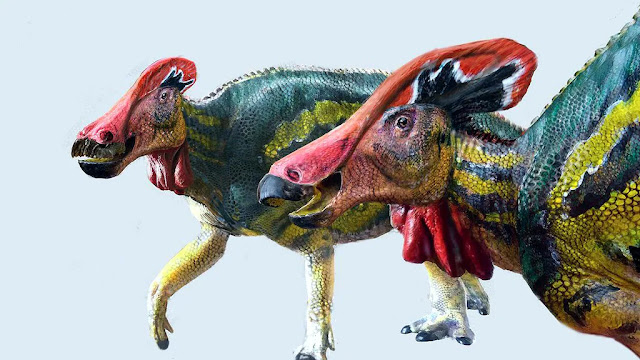New species of dinosaur found, colorful crest on the head ... used to talk a lot D
Dinosaurfound in Mexico made noises like elephants to communicate
By Mr DIGVIJAY
A new species of dinosaur identified by Mexican palaeontologists is believed to have been "very communicative" and used low-frequency sounds like elephants to talk to each other, a researcher said Friday.
Key points:
The new species of dinosaur was found in 2013, with the fossils being studied since
Named Tlatolophus galorum, researchers believe its crest may have been red
The discovery is still under investigation but the research has been published in the scientific journal Cretaceous Research
The specimen, which has been named Tlatolophus galorum, is thought to have died around 72 million years ago in what is now Mexico's northern state of Coahuila.
After initially discovering the tail in 2013, palaeontologists said they later found most of its skull, a 1.32-metre bony hollow crest through which it communicated, as well as bones such as its femur and shoulder.
"We are calculating the size, which could be between eight metres and 12 metres long because just the tail is around six metres," palaeobiologist Angel Alejandro Ramirez said.
"We believe that these dinosaurs were very communicative.
"They even produced and perceived low-frequency sounds like those made by elephants, which travel several kilometres and are imperceptible to humans."
These "peaceful, but talkative" dinosaurs could also have had the ability to emit loud sounds to scare off predators, the National Institute of Anthropology and History (INAH) said on Thursday when it announced the discovery.
Mexican researchers think Tlatolophus galorum's crest may have been red.
"We believe that these dinosaurs, like modern birds, saw in colour and so these structures like the crest were possibly brightly coloured. They could have been completely red, or multi-coloured, with spots," Mr Ramirez said.
 |
| The first fossils of the Tlatolophus galorum were found almost a decade ago.(INAH via Reuters) |
The discovery is still under investigation, but research about the ancient reptile has already been published in the scientific journal Cretaceous Research, according to the INAH.
"It is an exceptional case in Mexican palaeontology," it said.
"Highly favourable events had to occur millions of years ago, when Coahuila was a tropical region, for it to be conserved in the conditions it was found in."
The name Tlatolophus is derived from tlahtolli — which means word in the indigenous Nahuatl language — and lophus, meaning crest in Greek, the researchers said.







0 Comments